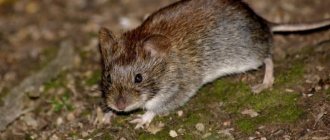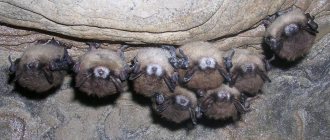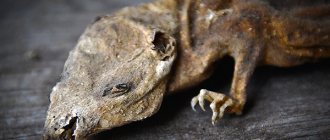External differences
The main signs of differences between rats and mice can be observed in external characteristics. First of all, they are clearly visible in the mass of animals, as well as in the structure of the body. Based on them, you can easily determine which representative of the rodent family is in front of you.
Dimensions
The most significant difference between rodents is determined by size. Rats have significantly larger dimensions and a stocky body. The length of an adult can reach 30 cm, not counting the tail. At the same time, weight indicators fluctuate between 600–700 g. A mouse is a smaller rodent. It rarely grows more than 10 cm in length, and its weight does not exceed 30 g.
Tail
It is also not difficult to distinguish animals by the characteristics of the tail. In rats, it looks more massive, thick, has an impressive length, which is sometimes not inferior to the length of the main body, and sometimes exceeds it, reaching up to 35 cm. The tail is bald or bristly, depending on the species. In small rodents, the length of the tail ranges from 4 to 6 cm, almost all over it is covered with small hairs.
Find out also what to feed and how to care for a decorative rat.
Head
The shape of the head of a rat and a mouse also has significant differences. The former has a more elongated, pointed muzzle. The organs of vision are poorly developed. Small black or red eyes are deep-set and have a small viewing angle, so the animals have to constantly turn their heads to examine their surroundings. It is interesting that they see it in gray tones, and red objects are transformed into black.
In mice, the shape of the head is more rounded, flattened, and its size is much smaller. But the eyes, compared to the size of the muzzle, are large, convex, and expressive. The animal has developed farsightedness.
Important! Both types of rodents have teeth that grow throughout their lives, so they need to be given hard objects to chew on that can wear down their incisors.
Paws
There are practically no calluses on the rat's paws, which are necessary for climbing. But there are movable fingers with sharp claws. Thanks to this property, rodents can move freely through trees. Sometimes they make homes for themselves in abandoned hollows. The excellent muscularity of the paws allows rodents to jump long distances. Another advantage of the limbs is the presence of membranes between the fingers, which are similar in appearance to folds of skin.
They make rats excellent swimmers, capable of obtaining food in a body of water. When moving along a horizontal surface, the paws of rodents are widely spread. If you manage to examine the footprint, you will notice that the angle between the outer phalanges is about 180°. Since the predator often moves by jumping, the distance between the tracks can also be impressive.
You may find it useful to know what types of domestic rodents there are.
The legs of mice are short. Each of them has 5 tenacious fingers, so these small rodents are able to move through trees. However, their limbs are not as powerful as those of rats. They move mainly in mincing steps, with the toes spread minimally, and the distance between the tracks is about 1 cm.
Wool
Mice have softer, more delicate fur. In nature, its predominant color is brownish-gray or ash-gray, but it can vary depending on the environment. For example, desert mice have a yellow-sandy coat color, and among decorative species there are white, black, gray-blue, and variegated tones.
Did you know? Mice keep their homes clean and tidy, and with droppings they mark routes to food sources.
Rats have thicker, longer, and coarser fur. The most common colors are gray and dark brown. In individuals bred as decorative domesticated animals, many other shades are found: white, gray, reddish, spotted, etc.
Ears
The rat's ears are straight, even, pointed towards the top.] Hearing is very well developed - the animal perceives sounds with a frequency of up to 40 kHz, while humans - up to 20 kHz. In mice, this figure is even higher - animals perceive sounds with a frequency of up to 100 kHz, although the hearing organs themselves are small, rounded, rolled up.
What is the difference between a baby rat and a mouse?
Norushki are capable of constantly falling into the same trap. The animals without hesitation swallow bait with poison and climb into mousetraps.
A rat is not so easy to deceive
She spends a long time sniffing at suspicious objects and behaves cautiously. The animal can identify traps and traps for rats and avoids them
The rodent is able to explore the surrounding space and analyze. If the area is safe and comfortable, the rat will lead the rest of the pack there.
People who keep decorative rats claim that their favorite rats respond to their name, recognize the one who feeds and waters them and learns simple tricks. Mice are not capable of this.
Baby rats and mice
Baby mice and baby rats have the following differences:
- Mice have a pointed muzzle. Baby rats have a blunt nose.
- The mice's ears are large and round. Rats have a triangular ear that is pressed to the skull.
- The tail of a newborn minnow is long, but in rat pups it is thick and short.
- Small mice do not have skin folds between their fingers.
A baby rat reaches the size of an adult mouse in a month. At this point, it becomes difficult for many to distinguish a mouse from a baby rat. If the animals cannot be seen closely, then you need to navigate by the rat’s trail on the snow or ground that they leave:
- The print of mouse limbs does not show webbing between the toes.
- Rat tracks are located at a distance from each other. Fingers stuck out. The paw print is wide.
If you compare what baby rats and mice look like in the photo, it’s not difficult to distinguish the babies.
If it is difficult to recognize the difference between a mouse and a rat, then you should look into a pet store. Decorative animals behave in the same way as their wild relatives. The appearance of the animals also does not differ much from those of “free” rodents.
The mouse's body is small and round, with a short rounded muzzle and large beady eyes. The hearing organs of mice also have considerable size in comparison with the head; unlike those of rats, they are thinner and rounded.
The fur of a mouse is silky and soft, with a particularly striking example of the difference being the fur of a mature male rat, which is more like coarse lint. Of course, most ordinary people are unlikely to ever want to intentionally touch these animals in order to make sure of the difference, but for those who kept such pets, this difference is obvious.
The jaws of rats have two pairs of fairly long incisors. The primary molars are designed to thoroughly grind food, so they grow in dense rows. Despite the fact that rats are considered predators, they do not have the fangs inherent in the latter.
Another extremely interesting fact about how mice differ from rats is the following: rats have more nipples. Mice have 10 of them, rats have two more. But despite this difference, the animals have the same average litter, which is about 8-9 cubs.
Rats have more developed intelligence than mice (this also applies to domesticated rats and mice). But this does not mean at all that a mouse is a bad pet. Decorative rats are very smart animals that quickly make contact, and they also quickly become attached to their owner.
They are trainable and can express their affection and love. In addition, the decorative domesticated rat knows and responds to its name when it is called to itself, especially if the owner offers some kind of delicacy or fun activity.
Essentially, the intelligence of a pet rat can be compared to that of other pets (cats and dogs). Rats are sociable animals that respond well to people, as evidenced by their love of games.
Note that even in natural conditions, rats are smarter than their smaller brothers - mice
For example, a wild rat is not so easy to catch, this is explained by its caution. She will never eat unfamiliar food found in a new territory she has just entered.
That is, these animals are much more difficult to trap or poison.
Differences in behavior
Both rodents are capable of causing enormous harm to humans. Not only do they brazenly eat food supplies, they also bite a lot of things on their way, rendering not only food unusable, but also household items, clothes, and shoes. They are carriers of serious diseases and infections dangerous to humans. It is difficult to get rid of mice and rats, since both types of rodents are unpretentious and can live in various conditions - in cold basements, hot boiler rooms, etc.
Did you know? It has long been believed that of all the creatures on the planet, only humans can laugh, but American scientists have proven that rats, who also have a sense of humor, also have this ability.
The speed that running animals are capable of developing is quite high in relation to their size. Mice move faster, moving at speeds of up to 13 km/h. Rats are slightly inferior to them in “sprinting”. The maximum speed developed by gray “robbers” is 10 km/h, but at the same time they are able to jump over obstacles up to 80 cm high and make long flight jumps at a distance of up to 1 m. Both mice and rats are able to fit into very small holes and hold on perfectly on the water.
There are some differences in the lifestyle of these two types of rodents. Mice in nature live in colonies with a clearly expressed hierarchical structure. However, they obtain food individually, and therefore feed mainly on “harmless” food, rarely attacking insects that they are able to overcome on their own. The animals are quite shy and cautious.
Rats hunt more often in packs and are more aggressive. In a group, they may well attack a mammal that is larger than them. When danger approaches, they show incredible courage, and in self-defense they can even attack a person. There is also a difference in the activity of the animals. Mice sleep much more often, plunging into the “kingdom of Morpheus” about 15 times a day. Moreover, their sleep is short, and each period of activity lasts 30–60 minutes. Rats, as a rule, sleep once a day.
Familiarize yourself with the behavior, care and nutrition of rats at home.
Who's smarter
The rat is one of the smartest animals. She has a highly developed intellect, thanks to which, according to scientists, she is able to analyze information. Animals easily adopt the experience of their ancestors and, as far as possible, do not repeat their mistakes. If a rodent falls into a trap, it will signal danger to other members of the pack, who will try to leave the area. Rats are trainable and can be taught to perform a lot of tricks.
Mice are not inferior in brain size to body size, but in an intellectual battle they will definitely lose to rats. They are extremely difficult to train, although sometimes they get used to their name and respond to it. They remember routes leading to food sources and are able to stock up based on their instincts. Otherwise, their mental abilities are much weaker.
What do rats and mice have in common?
These mammals belong to the order of rodents of the mouse family. There are other common features. Because of them, these two species are often confused.
Mice and rats: general features of life
Both of them belong to cosmopolitan species. That is, these rodents inhabit all corners of the Earth except Antarctica and the Far North, and they are not found high in the mountains.
These rodents are considered synanthropic, that is, associated with humans. Wild subspecies live in human homes, utility rooms or those intended for keeping pets. Although in warm regions they can live far from human habitation.
Rodents are animals with a nocturnal and twilight lifestyle. They are most active at sunset. However, when kept in captivity, animals adapt to the rhythm of life of the owner, get used to staying awake in the light and reducing activity during human rest.
These types of rodents are very active. They climb, run, jump and swim beautifully. Possessing high plasticity of the body, the animals can “leak” into very small crevices.
In nature, mice prefer to live in colonies in which they maintain a hierarchy. Adult males can start fights among themselves. In families, aggression sometimes spreads to older offspring, which the parents expel from their territory.
Rodents are clean creatures. They keep their homes clean and tidy. The droppings and piles of dust held together by urine that they leave while moving are special marks for determining the route.
Both types of rodents not only live in nature, but also take root in captivity and are easily tamed. Today, breeders, which many fanciers are happy to keep as companion animals.
Similarity in appearance
The mouse really looks like a smaller copy of a rat:
- The house mouse and are covered with horny scales and sparse short hairs. Only the black rat stands out here. Her tail is covered with thick hair.
- Both species have round black eyes (in albinos they are red or dark ruby).
- The main characteristics of these two types of rodents are long, sharp incisors that grow throughout their lives and the absence of fangs. With their teeth, animals can gnaw through very hard materials, even concrete.
Important! Keeping in mind the characteristics of the teeth of these rodents, when keeping animals, it is necessary to give them the opportunity to grind down their incisors. To do this, pets are given twigs with a diameter of 2-4 cm and pieces of charcoal in their cages.
Life expectancy difference
Mice live very little in the wild and at home - their average lifespan is 1.5–2 years. Despite this, the colonies of these animals grow quite quickly, since rodents are able to give birth to offspring already at the age of 8–9 weeks. Moreover, additions to the family can occur up to 10 times a year.
You will be interested to know how many years decorative house mice live.
The lifespan of rats is longer - up to 3 years. They also become “parents” quite early, reproducing up to 12 members of the offspring at a time.
Differences in nutrition
In the warm spring-summer period in the natural environment, the mouse prefers to eat plant seeds and cereals. Field animals feast on wheat, buckwheat, and oats. Rodents living in forests prefer hazel nuts, acorns, and can even feed on small insects. Near reservoirs they find roots and stems of plants, berries, and larvae.
With the arrival of autumn cold weather, the mouse begins to actively look for warm places to eat, moving closer to humans. Penetrating into a home, it becomes omnivorous. In addition to any edible food, she will not disdain such products as soap or candles. Animals cause particular harm to stocks of vegetables stored in the basement, to cereals in bags, they can chew wires, and inhabit shelves with linen and clothes.
Important! Ornamental rodents should not be given raw meat, lard and smoked meats.
Rats bring even more trouble. These rodents are capable of causing damage to anything in their path, including wires and structures. Everything that humans eat suits them perfectly. Under natural conditions, rats need food high in protein, feeding on fish, amphibians, and insectivores. By nature they are predators, they destroy bird nests, and can eat small rodents, including mice.
At home, a large rodent eats any food products and waste, and does not disdain feed intended for livestock and poultry. The rat does not store supplies, but without food it dies quite quickly, after 3–4 days. Her diet must contain water or food containing a lot of moisture. Without receiving it, the rats die within a few days. As for domesticated ornamental species of rodents, it is recommended to feed them with grain feed and vegetables. Protein foods are served in the form of boiled chicken, egg whites, and cottage cheese.
Read how to properly bathe a rat at home.
Fighting mice and rats
It should be noted the high fertility of both mice and rats. Each pair of these animals is capable of producing 5-7 cubs in each litter. Moreover, there can be about 10 such litters per year. Representatives of both species are very good parents. They not only protect and feed the cubs, but also teach them the art of living in a world where everyone is their enemy.
This rate of reproduction is well explained by the fact that in nature these rodents are the food source for many species of predators - from small mustelids and falcons to wolves and even bears.
Congestions of mice and rats have always been sources of such dangerous diseases as bubonic plague, tularemia, hemorrhagic fever, leptospirosis, etc.
So mice and rats in nature perform a very important mission as food supply for a large number of species. But in human homes they are persona non grata. The war with mice and rats lasts throughout the history of human civilization, but the complete victory of people never comes.
There are still a number of questions left to answer.
If a person is overcome not only by mice, but also by rats, how to cope with this?
Look for a cat from people you know (mongrel, of course) that is good at catching mice and squashing rats, take a kitten from her and raise it. Only he must grow up as a representative of a free tribe, and not as a fed toy.
You need to accustom such a cat to basements, sheds and all sorts of bins. Soon the rats and mice from there will run into the house. Now the cat needs to live at home, with its owners.
The fact is that rats and mice are smart creatures. After a while, all they will need is the scent of their enemy.
And if the cat can’t cope or for some reason you can’t get him, then it’s time for traps, crushes and chemical methods.
Rats and mice are rodents, but the animals are not related to each other. or pasyuki are natural enemies of mice. As soon as the first one appears in the house, the second ones begin to feel fear and try to leave the house as quickly as possible. To choose the right pest control method, you need to know what a rat and a mouse look like and how they differ.
What do newborn rats and mice look like?
Like all cubs, pups and mice have an attractive, funny appearance. Watching these harmless little lumps is pure tenderness. At first glance, they seem very similar, but upon closer examination, significant differences in appearance are clearly visible. First of all, you need to know that a newborn rat has a body length of about 3 cm, while it is completely naked, without any signs of fur. A mouse that has reached this length already has a fluffy coat.
Differences that are mostly similar to those present in adults:
- the mouse's body is more rounded. The animal prefers to sit huddled into a ball. Rats have a more elongated body, and they often like to rest stretched out, like cats;
- the tail of a large rodent is more powerful, occupying about 80% of the body length, while that of a small rodent is thin, barely more than 50%;
- The baby rat's muzzle is pointed and oblong. The hearing organs also have the same features. Mice have shorter and rounder heads, thin, rounded ears.
What is the difference between a baby rat and a mouse?
Rodent breeders claim that it is not difficult to distinguish a mouse from a baby rat. Babies are different sizes and look different. But for a person who does not see newborn animals every day, it can be difficult to figure out which species is in front of him.
Baby mice and baby rats have the following differences:
- Mice have a pointed muzzle. Baby rats have a blunt nose.
- The mice's ears are large and round. Rats have a triangular ear that is pressed to the skull.
- The tail of a newborn minnow is long, but in rat pups it is thick and short.
- Small mice do not have skin folds between their fingers.
A baby rat reaches the size of an adult mouse in a month. At this point, it becomes difficult for many to distinguish a mouse from a baby rat. If the animals cannot be seen closely, then you need to navigate along the ground they leave:
- The print of mouse limbs does not show webbing between the toes.
- Rat tracks are located at a distance from each other. Fingers stuck out. The paw print is wide.
If you compare what baby rats and mice look like in the photo, it’s not difficult to distinguish the babies.
If it is difficult to recognize the difference between a mouse and a rat, then you should look into a pet store. Decorative animals behave in the same way as their wild relatives. The appearance of the animals also does not differ much from those of “free” rodents.
Rats and mice belong to the order Rodents. If you don’t know the difference between them, it’s easy to confuse the animals. This will lead to an erroneous choice of means of destruction. Adults are characterized by different sizes: a rat is larger than a mouse. At the initial stage of development, young animals are more difficult to distinguish. To understand who is found in the house, they first study the features of the rodent’s body structure.
Small animals of several species are found in residential buildings. A house mouse lives near a person, as well as a gray, black or red rat.
The difference between rodents becomes noticeable if we evaluate each body parameter separately:
Dimensions. When thinking about what ordinary rats look like, the image of a large-bodied animal immediately comes to mind. The body length of this rodent reaches 30 cm. The mouse is smaller in size, the average individual is characterized by a length of up to 10 cm. Weight. Given the difference in size, it is logical to assume that the mass of animals also differs. For example, a mouse weighs between 30 and 50 g, while a fellow rat family reaches 900 g. Tail. Differs in length and thickness. This part of the mouse's body is shorter
You should also pay attention to the thickness. The mouse has a thin tail, while large rodents have a thick tail, which is more noticeable at the base
In addition, it is not covered with fur. The mouse tail is also different: it is hairy, and the color matches the color of the body. The eyes of the mouse are larger. Rodent ears also vary in size, shape and location. For example, in a mouse they are round, wide, and directed to the sides. Rat ears are flattened and distinguished by a small base. The shape of the head is also different. The muzzle of a rat is elongated, while that of a mouse is triangular in shape.
Relative to the head, the rat's eyes are small. Mice have more expressive and slightly convex black eyes.
In addition, pay attention to the wool. There are other differences besides color.
The rat is characterized by hard hair, and the mouse has softer hair.
Rats, unlike mice, are able to jump high - up to 2 meters in extreme situations. They are highly intelligent











